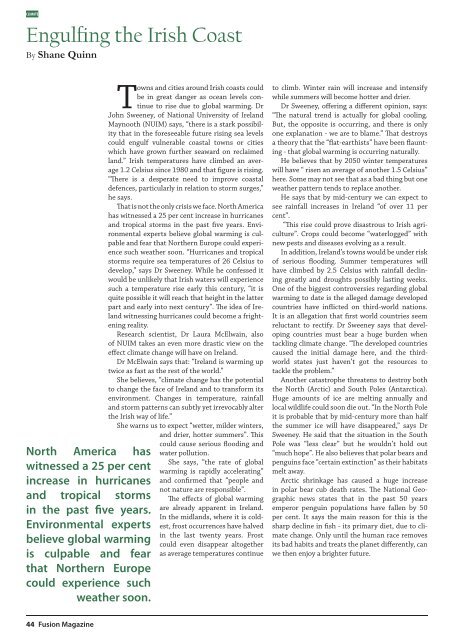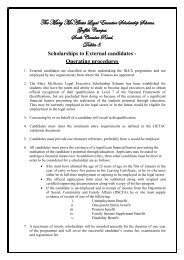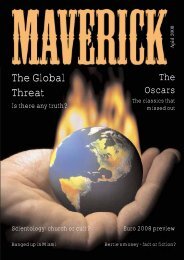Click here to View - Griffith College Dublin
Click here to View - Griffith College Dublin
Click here to View - Griffith College Dublin
- No tags were found...
You also want an ePaper? Increase the reach of your titles
YUMPU automatically turns print PDFs into web optimized ePapers that Google loves.
climateEngulfing the Irish CoastBy Shane QuinnNorth America haswitnessed a 25 per centincrease in hurricanesand tropical s<strong>to</strong>rmsin the past five years.Environmental expertsbelieve global warmingis culpable and fearthat Northern Europecould experience suchweather soon.Towns and cities around Irish coasts couldbe in great danger as ocean levels continue<strong>to</strong> rise due <strong>to</strong> global warming. DrJohn Sweeney, of National University of IrelandMaynooth (NUIM) says, “t<strong>here</strong> is a stark possibilitythat in the foreseeable future rising sea levelscould engulf vulnerable coastal <strong>to</strong>wns or citieswhich have grown further seaward on reclaimedland.” Irish temperatures have climbed an average1.2 Celsius since 1980 and that figure is rising.“T<strong>here</strong> is a desperate need <strong>to</strong> improve coastaldefences, particularly in relation <strong>to</strong> s<strong>to</strong>rm surges,”he says.That is not the only crisis we face. North Americahas witnessed a 25 per cent increase in hurricanesand tropical s<strong>to</strong>rms in the past five years. Environmentalexperts believe global warming is culpableand fear that Northern Europe could experiencesuch weather soon. “Hurricanes and tropicals<strong>to</strong>rms require sea temperatures of 26 Celsius <strong>to</strong>develop,” says Dr Sweeney. While he confessed itwould be unlikely that Irish waters will experiencesuch a temperature rise early this century, “it isquite possible it will reach that height in the latterpart and early in<strong>to</strong> next century”. The idea of Irelandwitnessing hurricanes could become a frighteningreality.Research scientist, Dr Laura McElwain, alsoof NUIM takes an even more drastic view on theeffect climate change will have on Ireland.Dr McElwain says that: “Ireland is warming uptwice as fast as the rest of the world.”She believes, “climate change has the potential<strong>to</strong> change the face of Ireland and <strong>to</strong> transform itsenvironment. Changes in temperature, rainfalland s<strong>to</strong>rm patterns can subtly yet irrevocably alterthe Irish way of life.”She warns us <strong>to</strong> expect “wetter, milder winters,and drier, hotter summers”. Thiscould cause serious flooding andwater pollution.She says, “the rate of globalwarming is rapidly accelerating”and confirmed that “people andnot nature are responsible”.The effects of global warmingare already apparent in Ireland.In the midlands, w<strong>here</strong> it is coldest,frost occurrences have halvedin the last twenty years. Frostcould even disappear al<strong>to</strong>getheras average temperatures continue<strong>to</strong> climb. Winter rain will increase and intensifywhile summers will become hotter and drier.Dr Sweeney, offering a different opinion, says:“The natural trend is actually for global cooling.But, the opposite is occurring, and t<strong>here</strong> is onlyone explanation - we are <strong>to</strong> blame.” That destroysa theory that the “flat-earthists” have been flaunting- that global warming is occurring naturally.He believes that by 2050 winter temperatureswill have “ risen an average of another 1.5 Celsius”<strong>here</strong>. Some may not see that as a bad thing but oneweather pattern tends <strong>to</strong> replace another.He says that by mid-century we can expect <strong>to</strong>see rainfall increases in Ireland “of over 11 percent”.“This rise could prove disastrous <strong>to</strong> Irish agriculture”.Crops could become “waterlogged” withnew pests and diseases evolving as a result.In addition, Ireland’s <strong>to</strong>wns would be under riskof serious flooding. Summer temperatures willhave climbed by 2.5 Celsius with rainfall declininggreatly and droughts possibly lasting weeks.One of the biggest controversies regarding globalwarming <strong>to</strong> date is the alleged damage developedcountries have inflicted on third-world nations.It is an allegation that first world countries seemreluctant <strong>to</strong> rectify. Dr Sweeney says that developingcountries must bear a huge burden whentackling climate change. “The developed countriescaused the initial damage <strong>here</strong>, and the thirdworldstates just haven’t got the resources <strong>to</strong>tackle the problem.”Another catastrophe threatens <strong>to</strong> destroy boththe North (Arctic) and South Poles (Antarctica).Huge amounts of ice are melting annually andlocal wildlife could soon die out. “In the North Poleit is probable that by mid-century more than halfthe summer ice will have disappeared,” says DrSweeney. He said that the situation in the SouthPole was “less clear” but he wouldn’t hold out“much hope”. He also believes that polar bears andpenguins face “certain extinction” as their habitatsmelt away.Arctic shrinkage has caused a huge increasein polar bear cub death rates. The National Geographicnews states that in the past 50 yearsemperor penguin populations have fallen by 50per cent. It says the main reason for this is thesharp decline in fish - its primary diet, due <strong>to</strong> climatechange. Only until the human race removesits bad habits and treats the planet differently, canwe then enjoy a brighter future.44 Fusion Magazine
















